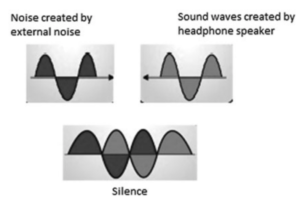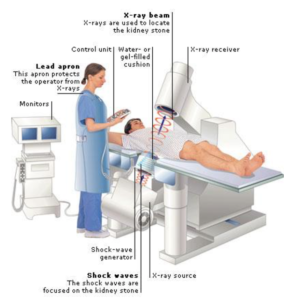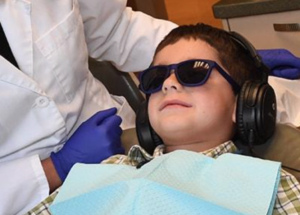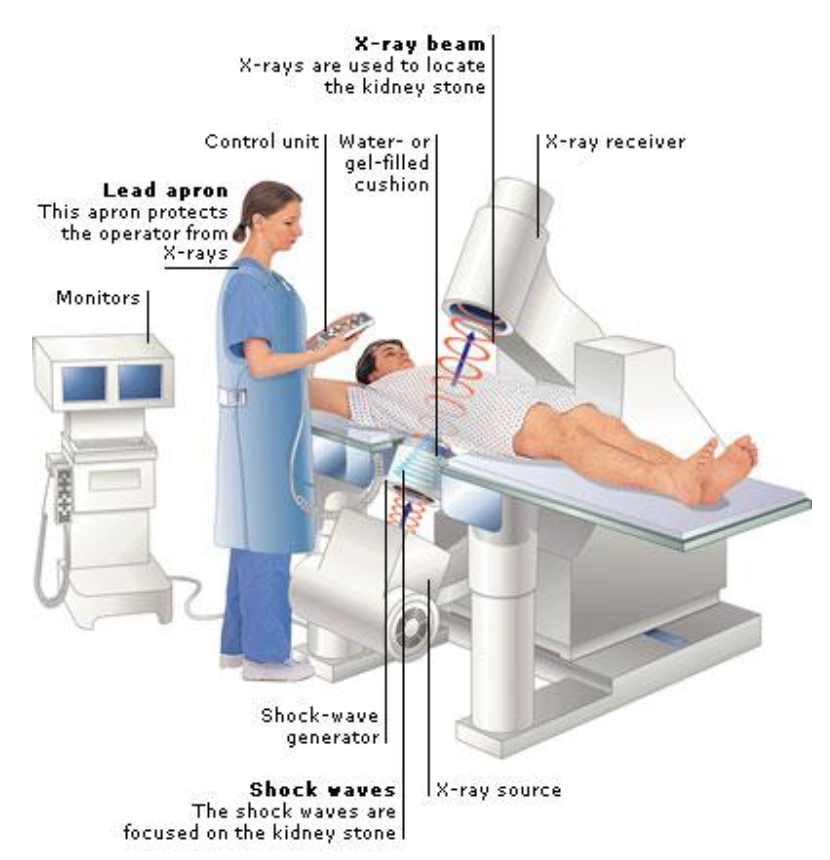Abstract
As the world seems to be getting louder and louder, noise-canceling headphones could be the potential answer to tuning noise out in many different situations. Born from the dissatisfaction of regular passive noise-reduction headphones, noise-canceling headphones utilize an internal speaker that actively produces a sound wave equal and opposite to that of external noise, inputted by a built-in microphone, to result in near silence. These headphones can positively impact people in their daily lives by reducing the risk of hearing repercussions as well as relieving pain and anxiety in medical procedures, such as an extracorporeal shockwave lithotripsy. Noise-canceling headphones can positively influence a patient’s experience and should be further studied for its potential benefits so that fewer drugs can be prescribed. Unfortunately, noise-canceling headphones are fairly expensive and therefore not everyone can experience their benefits without the financial burden. Individuals will need to weigh the pros and cons of the impact of these headphones to make the decision to invest into them.
Introduction
You are at a coffee shop, working on some homework while listening to music with some headphones. The girl at the table next to you starts Facetime-ing her best friend from home and laughs uncontrollably. Volume up. You diligently type one paragraph. Then you notice the group of students nearby loudly studying for an upcoming midterm. Volume up. You increase, increase, and then increase your volume again, nervously close to the forbidden maximum volume point. That same, single, and sad paragraph just sits in your document. Frustrated, you start ranting in your so-called “inside voice” to your friend next to you—assuming she is listening—and then pause for a supportive reply but only silence greets you. You turn your head to look at her and notice she is nodding her head not in response to your frazzled state but to the music coming from her noise-canceling headphones.
Headphones are a helpful tool for millions of people around the world. They attempt to tune out the endless amount of external noises that are a prominent part of the day-to-day routine. However, typical modern headphones may not do their job to the capacity desired and/or expected by users. And in certain situations, noise can negatively impact an individual by affecting their mood, mental state, and level of concentration. Thanks to advanced technology over the years, noise-canceling headphones are an alternative way to block out unwanted sound. With just a press of a button, you can ignore as many people as you want and enjoy the nearly complete silence or your preferred music.
They Can Be Better
Before the general public used regular headphones to binge watch television series or to listen to their favorite playlist, they had a more industrial use. In the late 19th century, telephone switchboard operators were the first to utilize headphones as a part of their occupation [1]. From then on, headphones were designed and manufactured for military use and then entered the consumer world in the late 1950s [1]. However, it only took one disappointed man named Amar Bose to bring headphones to the next level.
After a few decades in 1978, Amar Bose, founder of the Bose Corporation, had the opportunity to use recently created electronic headsets on a flight [2]. But, his experience was soon overpowered by the cabin noise. That was the moment that sparked his motivation to engineer a more effective way to shut out external, unwanted noise [2]. He started sketching designs on that same flight, and these sketches were the start of a revolutionary advancement in the headphone industry [2]. Like most great inventors, he faced an abundance of opposition and doubt, but he was determined to make this idea into a reality. In time, his noise canceling headset was on the market specifically for pilots in 1989 [2]. After years of improvements and additional use by the military, by 2000, the Bose corporation released the QuietComfort series for consumers [2]. The ability to noise-cancel was no longer restricted for a certain group of people, but available for anyone to purchase.
The Nitty-Gritty of Noise-Canceling Headphones
What exactly is sound? Sound is made up of waves. These waves are created by mechanical vibrations that travel through any state of matter [3]. They move air molecules in certain ways that produce sounds that our ears process and allow us to hear. Imagine the air molecules are like students at a university career fair. On one side, tons of students rush into dense lines near the well-known, prestigious companies. On the other side, a few students surround that one company nobody has ever heard of before. Likewise, sound moves the air molecules into highly-populated spaces (compressions) and also moves other air molecules into sparse spaces (rarefactions) [3]. This pattern is characteristic of longitudinal waves. For longitudinal waves, the direction the waves travel and the direction the air molecules move are parallel [3]. Sound waves produce different sounds due to varying amplitudes and frequencies. Amplitude has to do with the size of the waves and indicates how loud the sound is going to be. Frequency is the number of waves produced in a second: the higher the frequency, the higher the pitch, and vice versa. Certain combinations of the two create the different sounds that we hear.
Regular headphones, to a degree, block out some of the sound waves that are entering your ears. This is known as passive noise-reduction. Through using sound-absorbing material or simply physically being inside or covering your ears, passive headphones provide a low level of noise-reduction to enjoy whatever you choose to listen to [3]. In comparison, active noise-canceling headphones have a microphone built inside that takes external noises and actively creates equal and opposite sound waves into your ears, which essentially cancels the external noise [4]. This is regarded as destructive interference (see Figure 1), during which the amplitude and frequency of the two waves are the same.

Figure 1. Destructive interference [4].
Despite this, the waves occur at different times so that their interaction produces this cancellation effect, ideally resulting in silence. However, the headphones may fit a person’s ears one way, and another person’s a different way. Tightness of the headphones around the ears and how they interact with different ear stimulators influence the performance of noise-canceling headphones [5]. These factors complicate the expectation that noise-canceling headphones can completely negate any sound and at times can create pain when they are worn for an extended amount of time.
When to Noise-Cancel
Despite the potential inconveniences of fit, the active noise-canceling technology implemented into these headphones can benefit one’s physical and mental condition in some situations. Environments in daily life, as well as healthcare, are two areas in which noise-canceling headphones can do this.
Noise-Canceling in Daily Life
As the external sound increases, people tend to increase the volume on the device in use. This puts people at risk of suffering from partial hearing loss and potentially other hearing issues. Excessively loud or prolonged exposure can kill the ears’ sensory cells, which may equal saying goodbye to a portion of one’s hearing, not just for a couple of days but for the rest of one’s life [6]. Especially as people are exposed to listening to music with headphones at younger ages, this could be a possibility relatively early in their life. On top of listening to louder music, younger generations are exposed to dangerous levels of noise at popular entertainment venues such as bars and nightclubs [6]. To reduce this risk, the World Health Organization recommends properly-fitting noise-canceling headphones be integrated as a better substitute [6]. A study showed that while the noise-canceling feature was on, people’s “preferred listening levels” reduced in situations with background noise, compared to when regular ear buds were on [7]. People do not have to keep turning their volume up and up and up every time their surrounding gets louder to “accommodate” for the passive noise-reduction that normal headphones use. Using noise-canceling headphones maintains the volume at a lower and more consistent level, thus reducing the risk of irreversible hearing loss.
Noise-Canceling in Healthcare
Noise-canceling can also be beneficial to clients in the hospital. In a particular case, the noise-canceling headphones with music were compared to non-noise-canceling headphones with music amongst patients going through extracorporeal shockwave lithotripsy (ESWL) [4]. ESWL is a treatment for kidney stones by shooting shock waves at a stone to break it into tiny pieces [8]. Pain is often associated with ESWL and the patient’s pain and anxiety can be an obstacle to the success of the procedure [4]. It is not surprise especially because, as illustrated in Figure 2, a large machinery surrounds one’s body.

Figure 2. Extracorporeal shockwave lithotripsy.
This study demonstrated that the patient group assigned to noise-canceling headphones with music indicated significantly less pain than the groups without any music or headphones, and with music using non-noise-canceling headphones [4]. As this is a noninvasive approach to treat kidney stones, patients would benefit to undergo this procedure with the accompaniment of noise-canceling headphones. By addressing a patient’s pain and anxiety, it could yield shorter procedure times as well as better accuracy. This could also decrease the number of drugs prescribed to deal with the pain as well as prevent patients experiencing side effects [4]. Other medical procedures induce stress and anxiety that can impede the progress and smoothness. Hearing the whirring of machinery or other unknown noises could exacerbate these daunting feelings. These are promising opportunities for noise-canceling headphones to intervene and tend to a patient’s complaints.
Limitations to Noise-Cancelling Headphones
These implementations of noise-canceling headphones paint a bright future for society. One would imagine that with the existing benefits, we would see these headphones left and right. But unfortunately, one big barrier exists: the price. The price of the most popular models exceeds well over $300. It is clear that this is not a price that everyone can afford, especially for a technological accessory. Furthermore, as mentioned above, the headphones may not fit the user as well, and can even cause pain after a longer duration of time. However, these headphones could potentially ease the stress in your daily life by allowing you to press pause on the external sound and focus in on what you desire to hear. Therefore, all these considerations raise the question: is the heavy burden on your wallet an investment in a higher quality of life?
The Future: Applications for Children
Quality is life always has room for improvement, and that could be noise-cancelling headphones, especially for children. In addition to the potential use in medical procedures, noise-canceling headphones can also enter the dentistry field. There already seems to be a small community that utilizes this strategy for children (see Figure 3).

Figure 3. A Child Using Noise-Canceling Headphones at the Dentist.
This could be a less costly option in comparison to being put under anesthesia. Additionally, by fostering positive experiences at the dentist at an early age, the child will be less likely to grow up with negative connotations related to the dentist’s office.
Children with developmental disorders such as ADHD, or attention deficit hyperactivity disorder, can really benefit from using noise-canceling headphones to better perform academically. A study done on Donte, a 7-year-old diagnosed with ADHD, revealed that the combination of white noise played via noise-canceling headphones and his medication decreased verbal, motor, and passive off-task behavior as well as improved performance on classroom assignments [9]. This investigation suggests the integration of noise-canceling headphones can help advance personalized learning for children who may need extra assistance. Noise-canceling headphones shed light to so many domains in which they can improve an aspect of the user’s quality of life. As consumers, you all should take into consideration the pros and cons of noise-canceling headphones to enhance an experience and even decrease health risks for the user.
References
[1] G. Wells, “WSJ.D Technology: A History of Headphones: How the Technology Has
Evolved,” Wall Street Journal, Sept. 2016.
[2] F. Beacham, “How a ‘Genius’ Engineer Designed the First Noise Cancelling
Headsets,” The Broadcast Bridge, 19-Feb-2015. [Online]. Available: https://www.thebroadcastbridge.com/content/entry/1946/how-a-genius-engineer-designed-the-first-noise-cancelling-headsets. [Accessed: Jan. 31, 2019].
[3] W. Harris, “How Noise-canceling Headphones Work,” HowStuffWorks, 15-Feb-2007.
[Online]. Available: https://electronics.howstuffworks.com/gadgets/audio-music/noise-canceling-headphone.htm. [Accessed: Jan. 31, 2019].
[4] M. Karalar, I. Keles, E. Doğantekin, O. K. Kahveci, and H. Sarici, “Reduced Pain and
Anxiety with Music and Noise-Canceling Headphones During Shockwave Lithotripsy,” Journal of Endourology, vol. 30, no. 6, pp. 674–677, Jun. 2016.
[5] M. Guldenschuh, A. Sontacchi, M. Perkmann, and M. Opitz, “Assessment of active
noise cancelling headphones,” In Proc. IEEE Second International Conference on Consumer Electronics 2012.
[6] “1.1 billion people at risk of hearing loss,” World Health Organization, 27-Feb-2015. [Online]. Available: https://www.who.int/mediacentre/news/releases/2015/ear-care/en/. [Accessed: 17-Apr-2019].
[7] M. Liang, F. Zhao, D. French, and Y. Zheng, “Characteristics of noise-canceling
headphones to reduce the hearing hazard for MP3 users,” The Journal of The Acoustical Society of America, vol. 131, no. 6, pp. 4526–4534, Apr. 2012.
[8] “Kidney Stone Treatment: Shock Wave Lithotripsy,” The National Kidney Foundation,
Sep-2009. [Online]. Available: https://www.kidney.org/atoz/content/kidneystones_shockwave. [Accessed: 02-Feb-2019].
[9] A. Cook, C. Johnson, and S. Bradley-Johnson, “White Noise to Decrease Problem Behaviors in the Classroom for a Child With Attention Deficit Hyperactivity Disorder (ADHD),” Child and Family Behavior Therapy, pp. 38–50, Mar. 2015.




